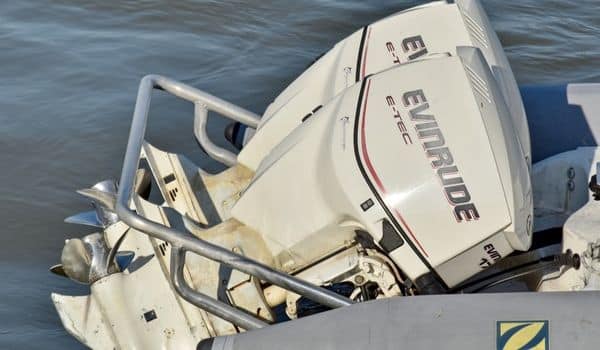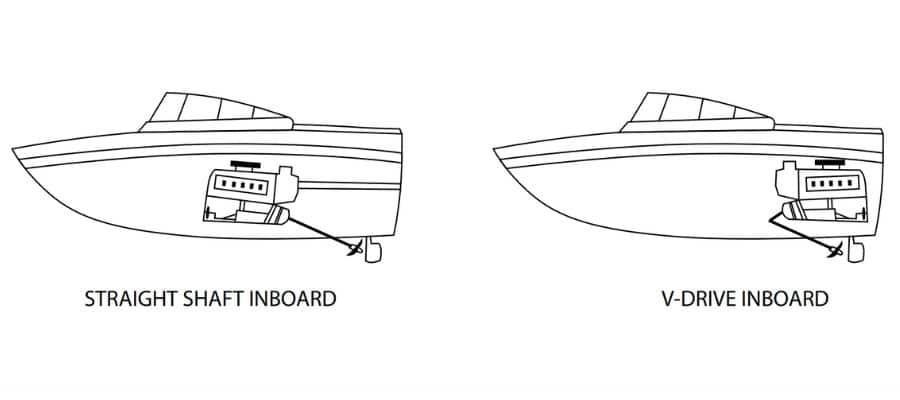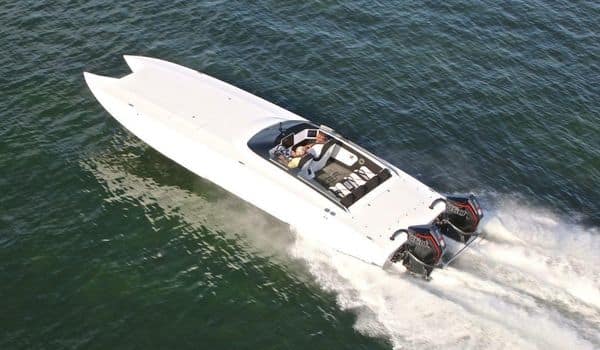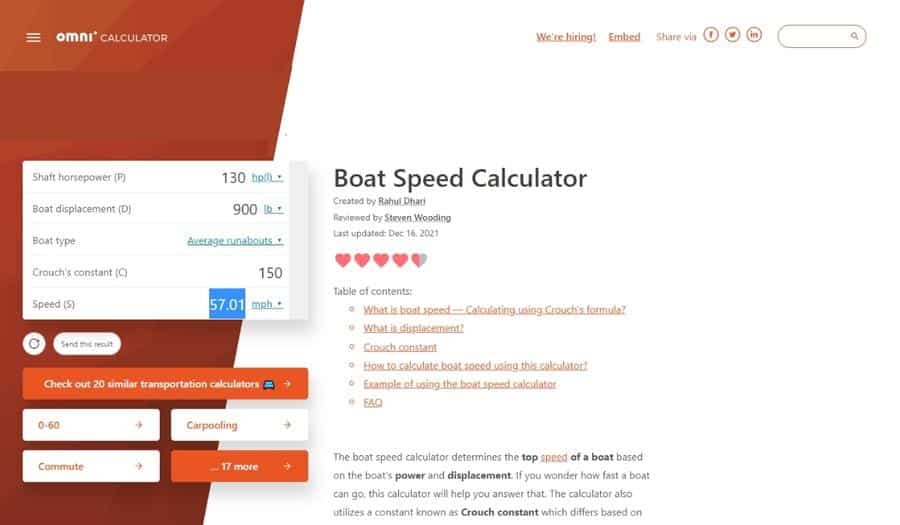Just like cars, there are many factors that go into determining the top speed each boat can go. The shape, engine, hull material and weight all play a significant role in determining the top speed. However, in this article, we will break down all the different boat types and explain how fast you should expect them to be able to go.
Most boats will go about 30-60 mph. Generally, boats such as pontoon boats, cabin cruisers, yachts, and trawlers have a top speed closer to 30 mph or less. Other boat types such as bass boats, ski boats, center consoles, and cuddy cabins will go closer to 60 mph or more.
Other boat types such as sailboats, dingies, and tug boats usually will only reach speeds of 10-20 mph. While jet skis, go-fast boats, and some bass boats can reach speeds of 55-100 mph.
20 different boat types and how fast they go
| Boat Type | Average Top Speed | Speed Range |
|---|---|---|
| Bass Boat | 55 mph | 40-75 mph |
| Ski Boat | 50 mph | 40-70 mph |
| Inflatable Dingy | 15 mph | 5-50 mph |
| Jet Ski | 55 mph | 40-70 mph |
| Pontoon Boat | 25 mph | 15-50 mph |
| Deep-V Fishing Boat | 50 mph | 30-70 mph |
| Center Console Boat | 55 mph | 40-75 mph |
| Dual Console Boat | 55 mph | 40-70 mph |
| Walkaround Boat | 45 mph | 35-65 mph |
| Deck Boat | 55 mph | 45-65 mph |
| Bay Boat | 45 mph | 35-65 mph |
| Sailboat | 13 mph | 5-25 mph |
| Cuddy Cabin | 50 mph | 40-60 mph |
| Cuddy Cabin (Go Fast Boat) | 70 mph | 60-90 mph |
| Catamaran (Go Fast Boat) | 80 mph | 70-100 mph |
| Cabin Cruiser | 45 mph | 40-60 mph |
| Yacht | 30 mph | 20-40 mph |
| Trawler | 17 mph | 10-30 mph |
| Tug Boat | 17 mph | 10-25 mph |
| Houseboat | 10 mph | 5-20 mph |
Related article: How Fast Are Jet Skis? (12 Examples Included)
What are the factors that determine how fast a boat can go?
As you can see, the speed of a boat can be drastically different, even ones of the same type. There are many factors that determine speed, such as engine horsepower, drive type, boat shape, boat weight, trim tabs, weather conditions, and more. However, in this article, we’re going to simplify it to the four that affect the boat the most.
1. Engine Horsepower
The amount of force propelling your boat forward is the number one factor that affects the speed of your boat. The more horsepower you have, the faster your boat will go. However, manufacturers set a limit to how much horsepower you can have depending on each type of boat they make.
This means many boat types are limited to only the speed they can reach with the maximum amount of horsepower allowed (which is usually plenty of speed).
Many times larger boats will put multiple engines in the back of their boat in order to get more power and travel faster, as shown in the image below.

2. Drive/engine type
There are generally three different types of boat engine types. These are outboards, inboards, and stern drives. Generally, outboards are the lightest, so they tend to be able to move a boat slightly faster than the other engine types. However, you can have more horsepower per engine with inboard and sterndrive engines.
The only thing that really affects the speed is the drive type. These consist of a jet drive, I/O, straight shaft, and V-drives.
Generally, jet drives lose the most amount of horsepower when transferring power from the engine to the jet. This means that a propeller-powered boat with a 200-horsepower engine may need to have a 250-300 horsepower engine to go the same speed at full throttle if it were jet drive.
Stern drives come in second when it comes to power loss. They lose about 10%-15% of the engine horsepower when converting it into the propeller. This is because they have to redirect power twice.
V-drive next, they lose about 6%-15%. This is because of the extra joint they need in order to transfer the drive shaft to the correct position. This causes them to have to redirect power at almost a 180-degree angle.

Straight shaft drives are the most efficient at turning engine horsepower into power for the propeller (this means they are the fastest considering engines with the same horsepower). This is because there are no areas where there needs to be power redirected. The drivetrain goes directly from the engine to the propeller.
3. Boat weight
Obviously, the heavier the boat, the slower it’s going to go with the same engine. So many manufacturers try to make their boats as light as possible, especially if they’re building a boat for speed, such as go-fast catamarans.
Aluminum boats weigh less than fiberglass boats, which means aluminum boats of the same size and same engine will generally go faster than fiberglass boats. However, most aluminum boats have an engine horsepower limit that is much lower than fiberglass boats, meaning they generally end up only being able to go the same speed due to power limits.
4. Boat shape
The design and shape of a boat play a big part in how fast it can go. The more surface area in the water, the more drag a boat will have against the water and the slower it will go. This is why many boats designed for speed will be designed to be very narrow or with catamarans such as the image below:

Meanwhile, boats that don’t care for speed and instead opt for more cargo or living space tend to have much wider hulls and lower drafts. Here is an example of such:

Boat speed calculator
If you know the weight, horsepower, and type of boat, you can get a good estimate of how fast it can go. You can do this by using this boat speed calculator from omnicalculator.com.
They make it really easy to just put in the information, and it will give you an estimate that should be very close to the speed your boat will be able to reach.
For example, I put in the information for my Sea-Doo Fish Pro Scout jet ski, which goes about 52-55 mph at full throttle. The calculator predicted, 57.01 mph, which still could have been my fault as its hard to predict the exact wet weight of the jet ski. You can see this in the image below:

Does speed feel faster when you’re on a boat compared to a vehicle on land?
The quick answer to this is, absolutely it does. When you’re on a boat, your open to the wind and water blistering past you as you pick up speed. This makes everything seem faster than on land. Even if you’re in an enclosed boat, the feel of cutting through water and bouncing to waves makes you feel more vulnerable when compared to being in a car, which means you feel as if you are going faster.
One thing to note is that the smaller your boat is, the faster you will feel like you are going. Going 40 mph in a big enclosed cabin cruiser may seem faster than in a car, but it doesn’t even compare to the feeling of going 40 mph on a jet ski.
The fact that some jet skis can reach 70 mph is absolutely astonishing. On my Sea-Doo jet ski, it’s hard to go any faster than 40 mph because I feel one bad wave will bump me off the thing if I go any faster. I couldn’t even imagine 70 mph.
Why would you need speed for a boat?
Although it’s fun and all to go fast on the water, for most of us, it’s really not necessary. Generally, it’s going to cost more for boats that go faster, when you could easily get a similar boat that goes a little slower for much cheaper. That being said, here are the main reasons you would want a boat that is fast:
- You fish in tournaments and need to get to fishing spots as quickly as possible
- You want to partake in a poker run
- You need to travel long distances every time you take your boat out
- You just enjoy going fast
Although many people max out the horsepower they are allowed to put on their boat (some even add more than what they are allowed to) to make it as fast as possible, is that really worth it to you? Believe me, 50 mph is plenty of speed for any boat type as long as you don’t absolutely need to go any faster than that.
- What Is The Cheapest Way To Store A Boat? - February 28, 2023
- Do Boats Need Bottom Paint? (Uncovering the Truth) - February 2, 2023
- How Much Is Bass Boat Insurance? (Real Quotes) - January 18, 2023

